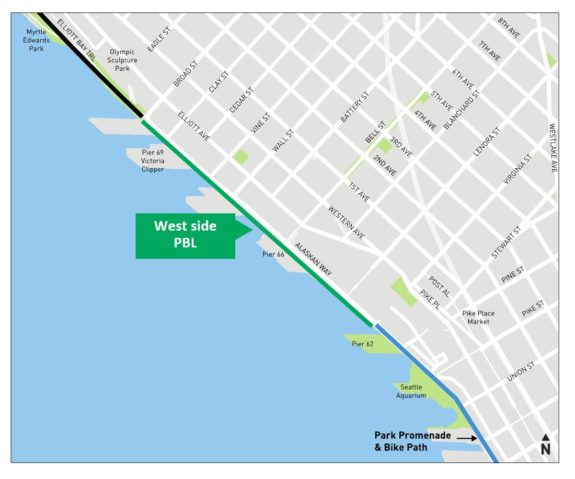
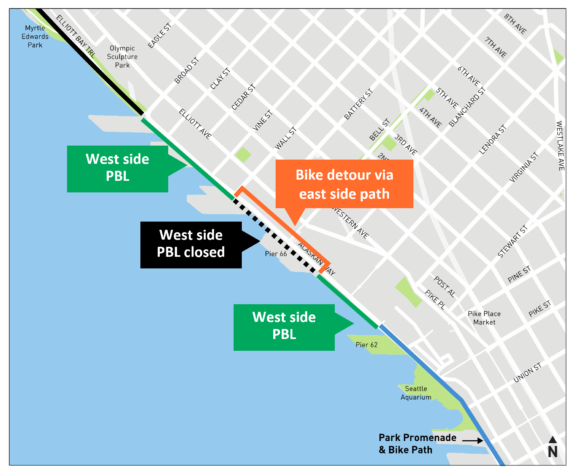
The city plans to build a continuous bike lane on the waterfront side of Alaskan Way under the latest design, SDOT announced Monday. Rather than permanently detour the bike route across Alaskan Way twice within a couple blocks, the new design includes a detour plan for use only during busy cruise ship loading times in the area around Pier 66. This compromise solution came together after significant discussions between the Port of Seattle, Cascade Bicycle Club and the city. A recent push by Seattle Neighborhood Greenways also got more members of the public involved, sending letters of bike lane support directly to Port Commissioners.
Cascade celebrated the news, writing in an email to supporters that “more than 700 of you joined us to ask planners to ‘go back to the drawing board.’ They did just that.”
“The new design creates a continuous, protected bike lane that will be open the majority of the year,” Cascade continued. “There will be a short detour only during cruise hours so that we can bike around the chaotic crowds (and their luggage). When it’s complete, families, visitors, commuters, and others can ride safely and comfortably along the waterfront without zig-zagging across the street and back for most of the year.” Cascade is encouraging people to use their handy online form to send a thank you note to the city’s transportation officials and leaders that also encourages sturdy bollards to protect the bike lane and intuitive signage and signalling when the detour is in place.
During cruise operations, the detour would cross at Blanchard and Wall Streets, which already have traffic signals. The path would then follow a path that is partially built already, though it appears the city will need to remove more of the old George Benson Streetcar tracks to create space for the path. Below are diagrams of the two intersections from SDOT:
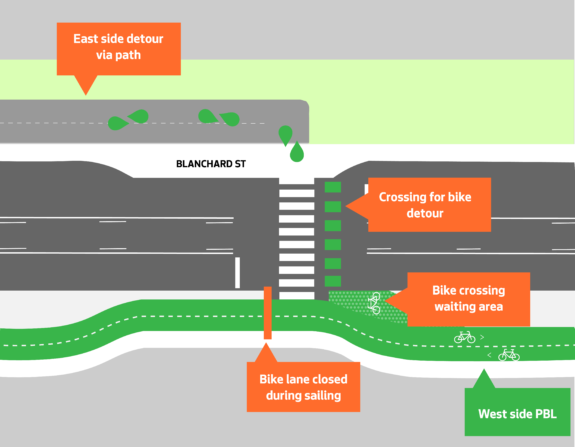
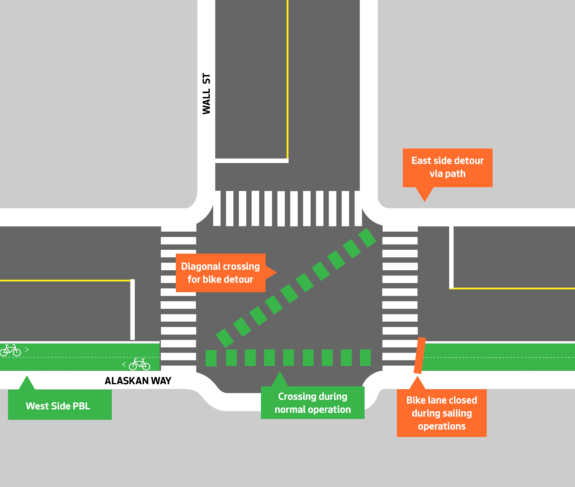
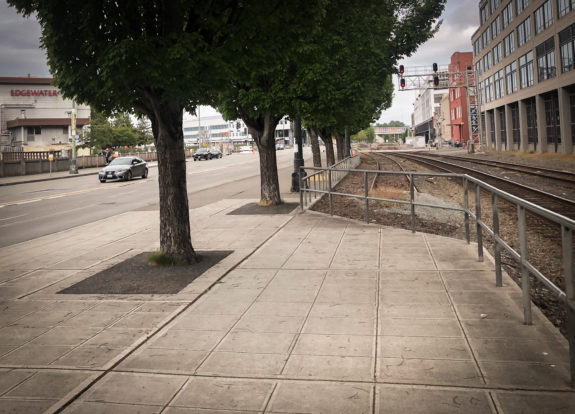
For both these crossings, the details will make or break the designs. If traffic cycle times are too long, for example, people may give up waiting and just bike in the street. But if the signals are responsive, people will follow the detour.
The crux of the unique design of this stretch of the waterside bike lane is a mountable curb lined with removable bollards. There are still details to work out here, such as how sturdy the bollards will be and what the procedures will be for removing them. But Seattle has had experience with a somewhat similar concept in the past. On N 34th Street in Fremont, the city built a two-way protected bike lane that is designed to be used by vendors during the Sunday Market. The city even spaced out the bollards to match the width of the average market canopy so that vendors could set up between them without needing to worry about a bollard getting in the way of customers, which is such a clever solution.
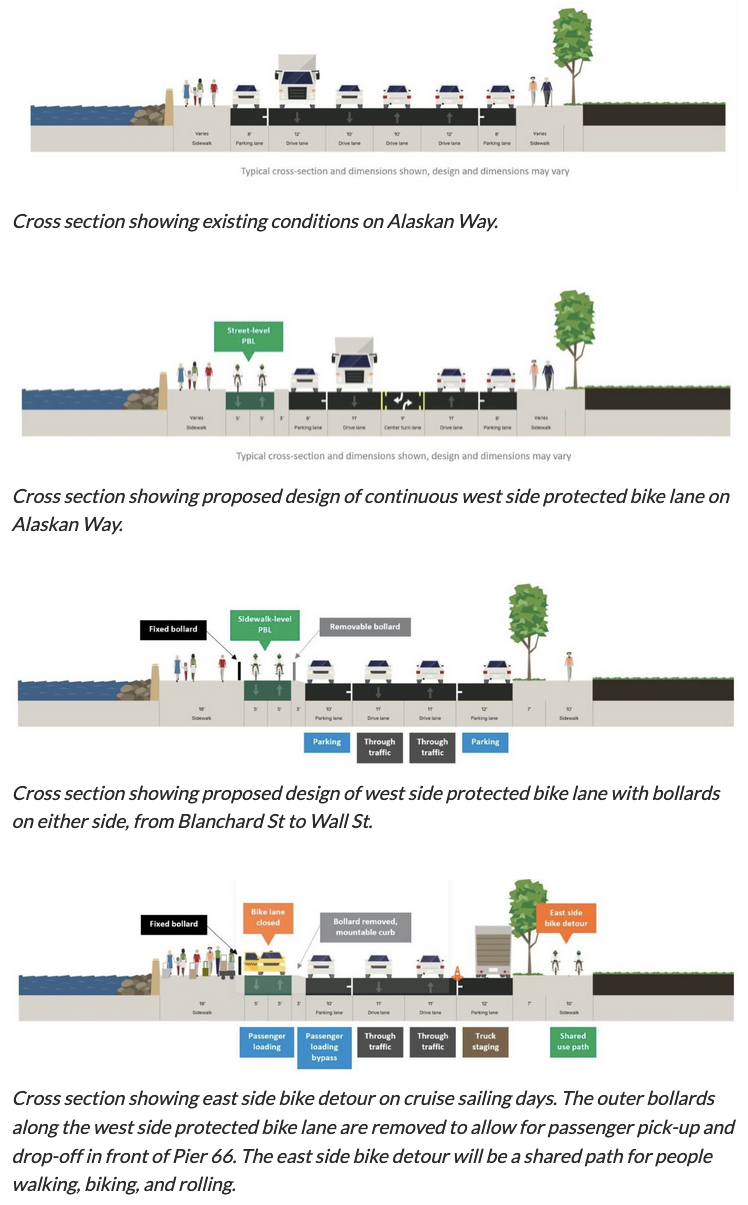
This “sensible compromise,” as Cascade calls it, puts the project on pace to be complete by mid-2025 along with the rest of the waterfront bike path, creating a complete and connected bike route for the entire downtown waterfront that connects to the West Seattle bike network in the south and the Elliott Bay Trail through Interbay and beyond to the north. This trail is likely to become the most impactful new bike route Seattle has constructed in many years, perhaps decades.
What should it be named?
Right now, parts of this trail is called the Alaskan Way Trail, other parts are referred to in city materials as the Waterfront Trail, and the section to the north has long been called the Elliott Bay Trail. I suspect that without an intentional renaming, people will refer to the whole thing as the Elliott Bay Trail or the Waterfront Trail. These could be fine names since people already use them, but the city could consider this opportunity for a whole new naming scheme to go with the opening. The branding and marketing of this new path is a chance to redraw people’s mental maps of the waterfront. People should be able to have one name to describe the mishmash of routes that are all finally coming together to become something new.
Here’s one idea: Because the whole waterfront trail route will connect to the existing Duwamish Trail and because one of the older names for Elliott Bay was “Duwamish Bay” and because this city is on the land of the Duwamish people, Seattle could use the name “Duwamish Trail” to refer to the whole trail from South Park to Smith Cove. This would also help clear up the naming for some sections of those West Seattle-bound trails that often refer to as the “Alki Trail” even though they aren’t really part of that trail. Instead, the Alki Trail could start where it intersects with the Duwamish Trail.
If you have other naming ideas, I’d love to hear them.







Comments
16 responses to “Latest Alaskan Way design includes continuous waterfront bike lane with plan for cruise detours”
I visited the waterfront today for the first time this year. (I wanted to see the new “beach” at the south end—it’s a nice place but needs trees at the top for some eventual shade.) It was sunny and warm and the entire length from Yesler almost to Broad was swarming with tourists. It was also under lots of construction and as far as bike riding goes, awful. Detours hard to see, pretty rough surface, places without detours too narrow, etc.
OTOH, most pedestrians were easy to avoid and alert to the bikes. The worst place of all—right in front of the cruise terminal. An arrogant employee who didn’t want to keep sidewalk open for anyone but their customers. They were loaded for bikes and ready to ignore at the first bell and yell “it’s a sidewalk” when I had to stopp and asked them to move so I could go through. Outrageous attitude. And having a heavy cane stuck in my face by a cruise customer for the trouble of arguing with the employee (who quickly disappeared).
I recommend the east sidewalk in the cruise terminal area but I don’t believe it goes through.
[Which avoids the whole issue of how awful the cruise industry is in the first place. Gotta have those cruise tourist dollars to replace the employees who don’t work downtown any more.]
I thought pedestrians had the right-of-way over cycles on the sidewalk. ?
Section 11.44.
Every person operating a bicycle upon a sidewalk or public path shall yield the right-of-way to any pedestrian thereon, and shall give an audible signal before overtaking and passing any pedestrian.
Rules of the Road – Transportation | seattle.gov
Seattle.gov
https://www.seattle.gov › programs › bike-program › rul…
Looks like one will have to cross Alaska Way twice to use the cruise loading detour. For this short distance it will probably be safer to just use the street when riding southbound.
I’m worried that the protected bike lanes will be overrun with pedestrians making them useless for riding. Will then have to just use the street as we do now.
SDOT seems to love installing two-way PBL. At their endpoints, there are awkward transitions. On Alaskan Way, I expect there will high demand periods when the 10-foot width will be too narrow. Note cyclists have varying speeds in addition to two directions. The narrow width may prompt faster cyclists to use the regular lanes. On those high demand summer days, will pedestrians spill onto the PBL? What will divide them? Should the PBL be at the street level rather than the sidewalk level?
I have been commuting on Alaskan Way since 1985. I make a north-to-east right turn to Broad Street. How does SDOT want this done from the two-way PBL?
Note that pedestrian users of the trail on the east side will be disrupted by the shift of the cyclists to the east from the west.
Yeah, contraflow cycletracks make turning weird. Can crosswalk the intersection like a ped or cross into the correct general-purpose lane a block or two early at a convenient signal. Once you go through somewhere a few times, you’ll pick up the tricks, e.g., westbound on BGT transitioning to 34th St.
SDOT loves the 2-way PBL because they can cram it into less space. The standard was supposed to be 12′ minimum, which they read down to 12′ in most places with the option to narrow down to 10′ in tight areas, which they read down to 10′ everywhere by saying the whole corridor is tight (on every project) with options to narrow further in places that are actually tight…
Dimond, yes, that is what SDOT did on Broadway. During that project, I looked up Montreal guidelines and they said two-way PBL should be 12-feet. At least Alaskan Way is flat.
I’m really appreciative that they are working with us and giving us a pretty awesome cycle track near the water. I currently use Western Ave at Yesler to avoid the crazy tourists and construction. I feel like seattleites just love to complain about anything and everything lol.
As for naming it the Duwamish trail, I find that very confusing. To connect with the duwamish, it has to curve to the west, over the west Seattle bridge, and then cut south. Elliott Bay trail makes a lot more sense because it’s a straight line extension from that trail.
What’s to keep cyclists from jumping up on the sidewalk to mingle with the peds? Certainly tourists on Lime bikes are very likely to do that (given they do that now).
The fact is right now, trucks and other vehicles supporting cruise ship loading deal with both peds and bikes crossing the driveways and using the road. Having bikes in a predictable space, even on the west side, will make it safer. Having bikes randomly picking (a) the sidewalk; (b) the street; (c) the detour won’t make it safer.
I like the naming idea but I’d really like to think of a different Lushootseed word. We’ve overused two or three words. Let’s ask our native partners what they would call it.
Sounds confusing. I will likely take the lane when the floating climate destroyers are in town. Frankly it’s sad that, with the many billions spent to reimagine the waterfront, this is the best we can do.
Regarding naming, the Duwamish Trail runs along the Duwamish River. It should start near the mouth of the river as it does today. I’d be cool with Elliott Bay Trail from Smith Cove all the way down to Spokane Street. I think if we’re going to use names that correspond to natural geographic features we should generally stay close to the geography. Using historic names for those features (like Duwamish Bay) is too cute by half — using the current names in common use helps people build a practical and common sense of the geography.
I’m generally sympathetic to the idea that bike routes that run consistently along streets should be known by the street name. That makes it easier for people that use streets in different ways to communicate about them, since we use the same name for them! Street names are already marked by prominent signs, used in addresses, and are the main unit of navigation (sometimes even placemaking) in American cities. That isn’t quite ideal here because Alaskan Way changes to East Marginal at a place where it doesn’t make sense for the bike route to change its name (also Alaskan Way isn’t a big part of the placemaking around here).
Yeah, I don’t think Alaskan Way Trail works here for the same reasons. Elliott Bay Trail is the obvious name, but I guess I’m tired of naming things after random white dudes who worked on old ships (it seems we aren’t even completely sure which Elliott it is named after). That’s why I’m positing that it’s a chance for something different if we want it. I’d be fine with Elliott Bay Trail otherwise. Waterfront Trail is ok, except that Seattle has a lot of waterfronts.
Yeah, for some weird reason we always call this specific area (i.e. between Myrtle Edwards and the ferries) “the waterfront”… so this part of the path will inevitably be called that to some extent.
I’m not sure any name applied to this bike path will have much power over how people broadly think about the area — it will be a too-narrow strip of asphalt between a too-wide road and its much more popular sidewalk (and the destinations along it). But having some name that only cyclists know does have the power to confuse people … specifically us!
And Seattle will F*** up the implementation by trying to mix bikes into pedestrian traffic. The safest way through will probably still be the road. SDOT cannot find a location that they cannot make worse for cyclists.